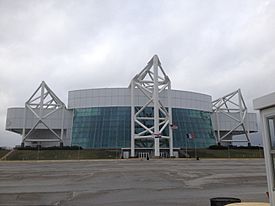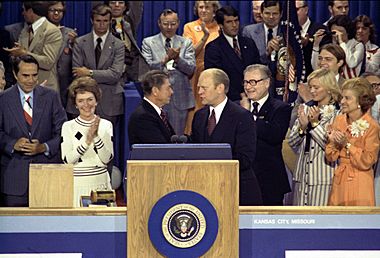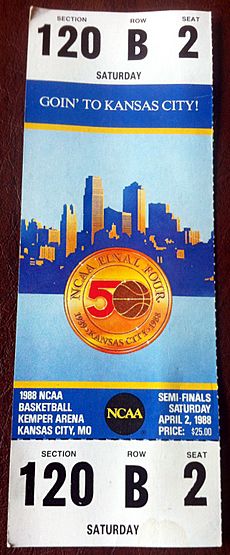Hy-Vee Arena facts for kids
 |
|

Exterior view of venue (c.2014)
|
|
| Former names | Kemper Arena (1974–2018) Mosaic Arena (2017) |
|---|---|
| Address | 1800 Genessee St Kansas City, Missouri 64102 |
| Location | West Bottoms |
| Owner | Foutch Brothers LLC |
| Capacity |
|
| Construction | |
| Broke ground | July 17, 1972 |
| Opened | September 30, 1974 |
| Renovated | 1976, 1987, 1996, 2017–2018 |
| Construction cost | $23 million ($161 million in 2022 dollars ) |
| Architect | Helmut Jahn |
| Services engineer | HNTB |
| General contractor | J. E. Dunn Construction Group |
| Tenants | |
| Former tenants: see the History section | |
|
Building details
|
|
| General information | |
| Groundbreaking | September 17, 2017 |
| Opened | October 5, 2018 |
| Renovation cost | $39 million |
| Renovating team | |
| Architect | Foutch Architecture and Development |
| Main contractor | McCownGordon Construction |
|
R. Crosby Kemper, Sr. Memorial Arena
|
|
| Architectural style | Modern |
| NRHP reference No. | 14000160 |
| Added to NRHP | September 9, 2016 |
The Hy-Vee Arena is a large indoor building in Kansas City, Missouri. It was once known as Kemper Arena. This building used to be a huge arena for professional sports. It could hold 19,500 people.
Today, it is a modern facility for youth sports. It has hosted many big events. These include NCAA basketball games and professional sports teams. It also hosted concerts and the American Royal livestock show. The arena was named after R. Crosby Kemper Sr., who helped fund it. Its unique design by Helmut Jahn made it a historic landmark.
Contents
History of the Arena
Building the Arena
Kemper Arena was built very quickly, in just 18 months, between 1973 and 1974. It was built where the old Kansas City Stockyards used to be. The goal was to replace the smaller Municipal Auditorium. This new arena would host Kansas City's professional basketball and hockey teams.
The arena was a very important early project for German architect Helmut Jahn. He later became a famous architect. The building was special because it had no inside columns blocking views. Its roof hung from large steel structures on the outside. This design was considered very new and clever at the time.
The building cost $22 million. The city of Kansas City, Missouri, owned it. Many different groups helped pay for it. These included city bonds, donations, and federal grants.
The 1970s and Big Events

In the 1970s, the arena won awards for its architecture. It also hosted several important teams and events:
- From 1974 to 1976, the Kansas City Scouts of the NHL played there.
- From 1974 to 1985, the Kansas City Kings of the NBA called it home.
- In 1976, it hosted the 1976 Republican National Convention. This is where the Republican Party chose its candidate for president. Gerald Ford was chosen over Ronald Reagan.
Roof Collapse in 1979
On June 4, 1979, a big storm hit Kansas City. Winds of 70 miles per hour and heavy rain caused part of the arena's roof to fall in. Luckily, no one was inside the arena at the time, so no one was hurt.
This event, along with another roof collapse in Connecticut, made architects rethink how they designed large buildings. The Kemper Arena's roof was designed to let rainwater drain slowly. But during the storm, water collected on the roof as it sagged. This added too much weight. Also, the bolts holding the roof were not strong enough for the heavy winds combined with the extra water weight. When one bolt broke, other parts of the roof quickly collapsed.
About one acre of the roof fell. The sudden drop in the roof caused air pressure to build up, pushing out some of the walls. However, the main support structures stayed strong. Investigators looked into what happened. The problems were fixed, and the arena reopened within a year.
A Hub for College Basketball
In the 1980s, the arena became famous for its college basketball games. It hosted many major tournaments, including:
- The NCAA Men's Final Four in 1988.
- The NCAA Women's Final Four in 1998.
- NCAA Regional games in 1983, 1986, 1992, and 1995.
- NCAA First and Second Rounds in 1997, 2001, and 2004.
- The NAIA basketball tournament for many years.
- The Big Eight Conference Men's Basketball Tournament from 1977 to 1996.
- The Big 12 Conference Men's Basketball Tournament several times.
The Kansas Jayhawks also played at least one game each year at Kemper Arena. This helped them connect with their fans in Kansas City.
Other Professional Sports Teams
Over the years, many other professional sports teams played at the arena:
- The Kansas City Scouts (NHL) from 1974 to 1976.
- The Kansas City Kings (NBA) from 1974 to 1985.
- The Kansas City Comets (indoor soccer) from 1981 to 1991.
- The Kansas City Attack (indoor soccer) from 1992 to 2005.
- The Kansas City Blades (hockey) from 1990 to 2001.
- The Kansas City Knights (basketball) from 2000 to 2002.
- The Kansas City Outlaws (hockey) from 2004 to 2005.
- The Kansas City Brigade (arena football) from 2006 to 2007.
- The Kansas City Renegades (indoor football) in 2013.
An Accident During a Wrestling Event
On May 23, 1999, the arena hosted a professional wrestling event called Over the Edge. During the show, a performer named Owen Hart was supposed to make a special entrance. He was to come down from the arena's ceiling. However, his equipment had a problem, and he fell into the ring. The event was paused for a short time. After some discussion, the show continued. Because of this accident, the "Over the Edge" event name was never used again.
Updates and Changes in the 1990s
In the early 1990s, new buildings for the American Royal livestock show were added next to Kemper Arena. This cost $33.4 million.
In 1997, the arena itself got a big upgrade costing $23 million. A major change was adding a glass-enclosed lobby on the east side. They also added 2,000 more seats, improved seating areas, new restrooms, and a special entrance for people with disabilities.
Becoming a Youth Sports Center
From 2017 to 2018, the arena went through a $29 million renovation. It was changed into a facility for youth sports. The updated arena now has 12 basketball courts. Four are on the lower level, and eight are on a new upper level. It also has a 350-meter indoor running track. Both levels have areas for shops and offices.
For a short time, it was going to be called Mosaic Arena. But then, the grocery store chain Hy-Vee bought the naming rights. So, on May 17, 2018, the arena officially became known as Hy-Vee Arena.
American Royal
The American Royal Association used to hold its livestock events at Kemper Arena. They even helped pay for the original building. Their offices and a museum were inside the arena. Later, the American Royal moved to a new complex that includes Hale Arena.
Images for kids
See also
 In Spanish: Kemper Arena para niños
In Spanish: Kemper Arena para niños



